|
| OO Scale | N Scale | G Scale | Z Scale | HO Scale | Slot Cars & R⁄C |
| |||||||
|
|||||||
| Home Page | |||||||
| BUY GIFT VOUCHERS | |||||||
| Products | |||||||
| Latest News | |||||||
| RIGHT LINES | |||||||
| Bargains | |||||||
| Downloads | |||||||
| Events | |||||||
| Careers & Jobs | |||||||
| Carriage Services | |||||||
| About Us | |||||||
| Contact Us | |||||||
| Pay Us A Visit | |||||||
| Meet The Staff | |||||||
| Links | |||||||
| SHOPPING BASKET |
Your shopping basket is empty. To add an item, click the "Buy" button
| YOUR ACCOUNT | ||
|
||||
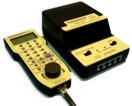 |
||||
| Prodigy Advance Digital System |
||||
| Cased Controllers |
||||
| Panel Mount Controllers |
||||
| Walkabout Controllers |
||||
| Modules & Transformers |
||||
| Scenics & Accessories |
||||
| Wiring & Electrical Components |
||||
| Tiny Signs | ||||
| Tools | ||||
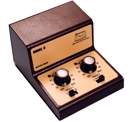 |
||||
| RECENTLY VIEWED |
| MODELSTRIP - Use GM08 |
| O Scale | Wargaming | Architectural | Narrow Gauge | Tools+ | ||
Ground Cover and Trees

In his continuing series of articles, NICK DUXFIELD explains how to enhance your layout.
Building Up The Ground Cover
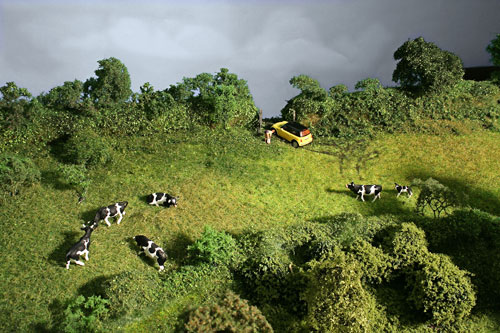
This is where the collections of variously coloured dusts, granules, flakes and chopped fibres we call scatters come into play.
It is best to do the grass and ground cover before planting trees and laying hedges. There are no hard and fast rules here - but keep to the season you are modelling - don't use red and golden Autumn tints on your trees is if the grass is in Spring green. Generally the greens in grass and trees is brighter and more varied in Spring than high Summer when grass turns pale as it dries out and the green of trees darkens before the onset of Autumnal colours.
Use a combination of foliage, scatters and grass flocks, the latter are fibres that, depending on length, represent short, medium and long grasses, to build up a varied texture. Noch's Grass-Master applies an electrostatic charge to flock fibres when the tool is gently shaken over the area to be covered causing the fibres to stand upright. Noch recommend their own grass glue that has an extended setting time similar to Deluxe Materials DLAD-09 Scatter Grip. Try not to let your textures and colours become too evenly and neatly laid. As mentioned earlier only cultivated ground is regular - 'nature' is very rough and ready.

Trees and Bushes
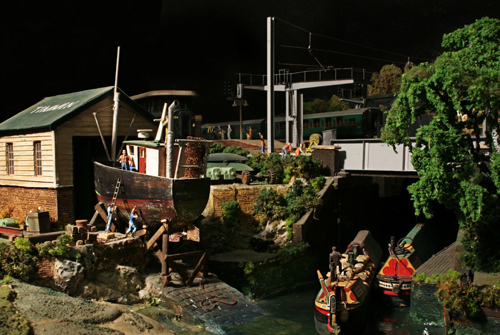
The density at which you need to 'plant' trees will depend on the terrain you have chosen, open moorland will have very few trees and these will be stunted and windblown, while coniferous forest will be dense and with much taller trees - Pines, Spruce and Larch. These trees, having densely packed needles rather than flat leaves, and generally dark blueish-green in colour are rather gloomy when compared with the lush, brighter greens of deciduous woods. Scots Pines are often seen in groups of three or four on sandy heathland. Here the trees will be tall, the older ones with contorted, golden brown trunks and branches with foliage only at their very tops.
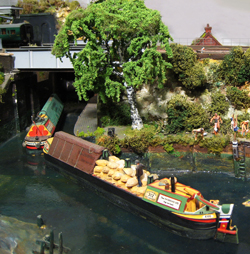
Trees in deciduous woodland are more widely spaced, although the canopy can be quite dense, often obscuring the ground when viewed from the air. Oak, Beech, Ash, Sycamore are typical. The shapes and colours also tend to be more variable than conifers.
CLICK HERE to view the Gaugemaster range of trees. The bulk packs of trees do not represent specific species but are ideal for economically covering large areas. A little careful snipping of the foliage will introduce a more random effect, particularly if you add some leaf scatters. Trees in the foreground need to be more detailed and are usually sold as named species.
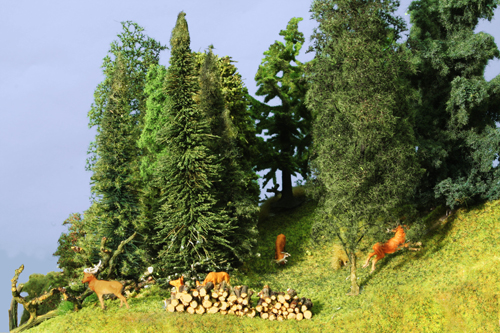
Trees are not difficult to make - especially if you use GM195 Sea Foam. This is a natural plant product, which even in its 'undressed' form looks very treelike. Once it has a covering of foliage scatter a Seafoam tree can be very realistic indeed. There is enough material in the box to create around fifty trees and bushes of assorted sizes. Very informative instructions on the pack include silhouettes of different deciduous trees with leaves on and off. A scale chart is also provided giving you scale heights in metres for OO/HO, N and Z trees. Many model railways have beautiful trees, most are sadly undersized, a fully grown Oak will be 23 to 30m high, Beeches reach around 25m - a little over a foot high.(300mm)
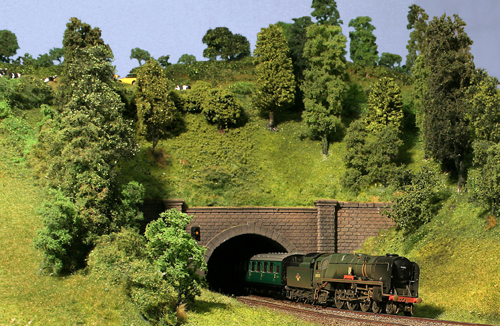
Hedgerows
Hedgerows are much looser in shape than trees and can made from small pieces of Sea Foam, Lichen or clumped foam scatters. Carefully tended hedges are regular in shape, others are quite ragged sometimes with small trees growing from them - all are broken at intervals by gates which might in galvanised steel or timber. Depending on the livestock and the time of year gateways will be trampled and muddy or littered with straw if a cereal crop has just been harvested. Grasses will be much longer when they are close to hedging. Ditches are often associated with hedges and certainly with rural lanes and roadways. For perfect and regular garden hedging, you cannot go wrong with GM160 and 161.
This article is adapted from the Gaugemaster Scenic Guide produced back in 2008. Although out of print a PDF copy can be viewed here![]() . Right click on the link and select 'Save Link As' to download the Guide rather than open it in your browser.
. Right click on the link and select 'Save Link As' to download the Guide rather than open it in your browser.
|
We are always looking to make improvements to our website to try and improve the quality of your visit. We would welcome your feedback and suggestions, so please do not hesitate to e-mail our webmaster with your comments. Alternatively call us on 01903 884488.
Home Cookies Privacy Statement Terms & Conditions Site Map Site Guide
WEEE Regulations Glossary Careers & Jobs
Tel – +44 (0) 1903 884488 Fax – +44 (0) 1903 884377 E-Mail us – click here
Gaugemaster.com is a trading name of Gaugemaster Controls Ltd.
Registered in England No. 2714470, Registered office:
Gaugemaster House, Ford Road
Arundel, West Sussex, BN18 0BN, United Kingdom
VAT Reg. No. 587 8089 71
Copyright © 2003-2014 Gaugemaster Controls Ltd. All Rights Reserved.
















